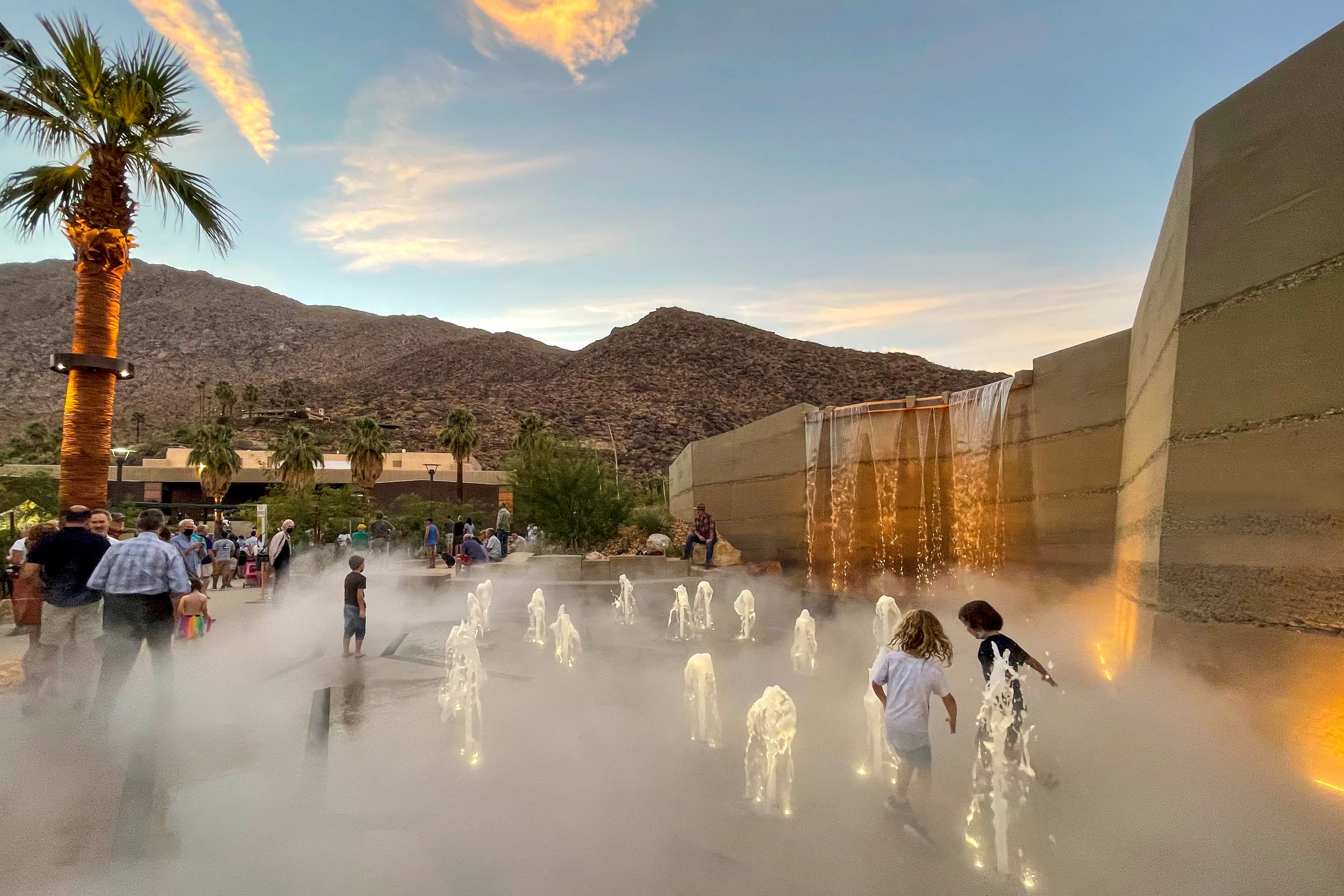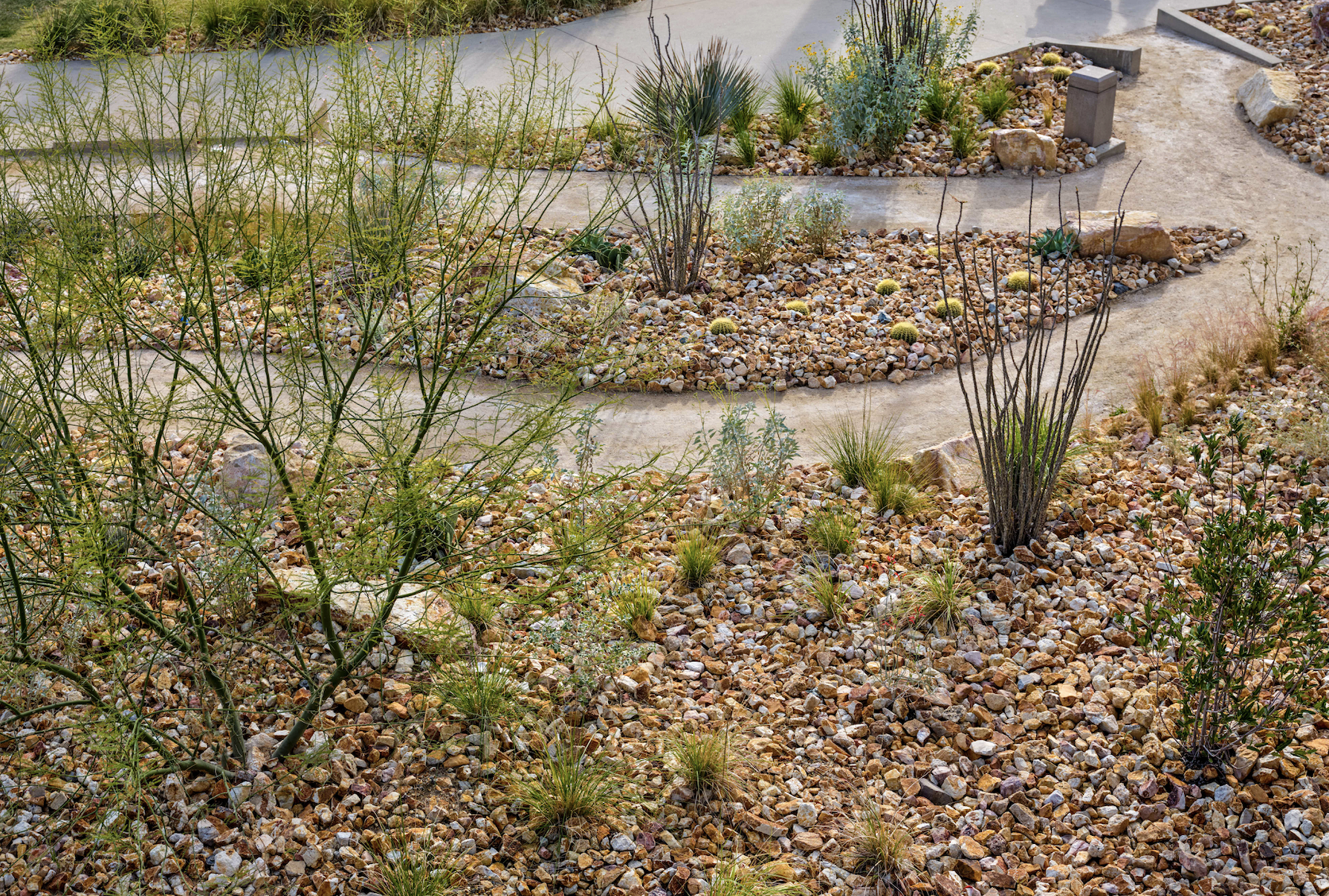Stillness, space, solitude and simplicity in Palm Springs
Palm Springs has an inviting new downtown park thanks to RIOS design collective.
The two-acre public open space, Palm Springs Downtown Park, is nestled at the base of the San Jacinto Mountains in California’s Sonoran Desert, and offers an oasis for residents and visitors alike.
Located in the ancestral homeland of the Agua Caliente band of the Cahuilla people, and on the historic site of Nellie Coffman’s Desert Inn, the park is inspired by Coffman’s four S’s- space, stillness, solitude and simplicity. Visitors are immersed in the beauty of the desert, and encouraged to celebrate Palm Springs as a destination for health, nature and pleasure-seekers.
Palm Springs Downtown Park.
The Palm Grove is densely planted to assist with the summer heat, which can exceed 48 degrees celsius. More than 130 Washintonia filifera, California’s sole native palm, have been arranged according to data collected on hikes in Palm Canyon; RIOS discovered that the canyon’s sandy floor and canopy created a cooling effect, and mapped the spacing of its palms. Varying heights were composed to create shaded areas, and 3D modelling of seasonal shade scenarios ensured thorough coverage.
Aluminium furnishings stay cool and are loose so visitors can move them to shaded spots throughout the day, and the Grove is illuminated after dark so it can be used in the cooler evening hours.
The park is located in the ancestral homeland of the Agua Caliente band of the Cahuilla people, and on the historic site of Nellie Coffman’s Desert Inn.
Palm Springs Downtown Park features an Outcrop along its northern edge, obscuring a nearby parking garage. RIOS were inspired by the Tahquitz Canyon, and have created shotcrete vertical walls and precast concrete modular seat blocks in a custom “sedimentary” finish.
The Outcrop’s layers reflect the reddish ombre tones of the San Jacintos, with rumpled sandstones along the base and smooth granite along the top. It forms a backdrop for a cascade inspired by Tahquitz Canyon’s waterfalls, an interactive water feature with jets and fog emitters that cools the park.
The Palm Grove is densely planted to assist with the summer heat.
A theatre honours the cultural heritage of Palm Springs and the Coachella Valley, hosting a range of events including live performances, lectures and film nights. An elevated stage with an event lawn and amphitheatre seat blocks have a capacity of over 1,000. The stage is framed by a shade canopy inspired by palm fronds, and features the backdrop of the Palm Springs Art Museum and the San Jacinto Mountains.
Local “Palm Springs Gold” stone was sourced from a nearby quarry and used as boulders, cobble mulch, concrete topcoats and decomposed granite in order to complement the tones of surrounding mountains. Native and regional desert plantings were selected for their climate suitability and ability to provide an ecological habitat, attract native pollinators and showcase the desert’s biodiversity. Mesquite and Palo verde trees offer shade, while hesperalow, bulbine and desert milkweed provide colour. A series of rain gardens also feature to receive and filter all stormwater.
The Outcrop’s layers reflect the reddish ombre tones of the San Jacintos.
Nate Cormier, Managing Landscape Studio Director at RIOS, says the park is “inspired by its legacy as the site of the Desert Inn, one of the earliest destinations for health and wellness in the desert. At the heart of the design are strategies to create comfortable outdoor spaces that are shady and cool to moderate the heat of the desert and bring people together for rest and recreation.”
RIOS’s Design Director, Jason Shinoda, adds that Palm Springs Downtown Park will feature, “distinctive elements that tie the park to its desert surroundings and modulate the environment to provide cooling and shade. The water feature, called the Spring, has cascading falls and an interactive splash zone to attract visitors and provide cool ambient temperatures. The sedimentary wall, or Outcrop, composed of layered rock and sands, was inspired by the geologic uplifts that created the native fan palm oases in the canyons surrounding Palm Springs. Each aspect of the design is very much rooted in the desert ecology and geology that make Palm Springs unique.”
Local “Palm Springs Gold” stone was sourced from a nearby quarry and used as boulders, cobble mulch, concrete topcoats and decomposed granite in order to complement the tones of surrounding mountains.




